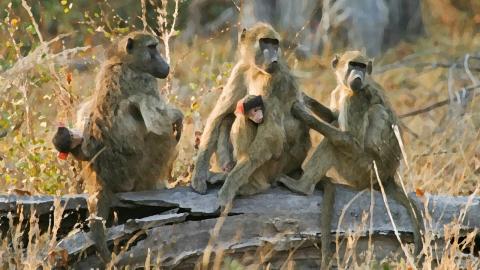
Article first appeared in the Duke Daily and npr.org December 14, 2021 by Vincent Acovino and Christopher Intagiata
We've all had to deal with breakups — with close friends or romantic partners. But breakups aren't a uniquely human phenomenon. Our primate cousins do it too.
Robert Seyfarth, a primatologist at the University of Pennsylvania, says there are a number of ways a breakup can go down in a group of primates.
"We have known for years that primate groups, like baboons and other African monkeys and chimpanzees and gorillas, that they grow in size. And at a certain point, they may split apart," Seyfarth said.
"The question was, how do they decide who goes with whom? Are they banding together with a tight little group of kin and splitting off in that group? Or is there some despot that is determining what they're doing?"
Now a group of scientists has come up with an answer. Groups of baboons seem to split into two smaller groups in a cooperative way, rather than at the whims of a tyrannical baboon. And as in the human world, these breakups can take months or years.
"It's not an event — it's a process," says Susan Alberts, a primatologist at Duke University. "And part of the process is negotiating which social relationships are going to get broken."
Alberts is one of the authors of a work published this week by the Royal Society. She said a group of baboons might just wake up in the morning with a difference of opinion.
Article continues after sponsor message
"Where this faction or this clique says, no, we're going to go off to that water hole, and this other clique says, well, we're going to go over to these azima bushes because the berries are ripe," Alberts said.
Alberts and her team studied seven real-world splits among wild baboons in Kenya. They mapped social bonds in those baboon groups and then studied how they broke apart.
Brian Lerch of the University of North Carolina at Chapel Hill led that analysis. He said these breakups could have big consequences for baboons.
"If you go through a bad breakup ... if you have a fission that disrupts your connection to your close social partners, then you might find yourself, after the fission, basically with no friends," Lerch said. "You might find yourself not having grooming partners and not having individuals to interact with."
Bibliographical Reference for this study:
Lerch Brian A., Abbott KarenCl, Archie Elizabeth A. and Alberts Susan C. 2021 Better baboon break-ups: collective decision theory of complex social network fissions. Proc. R. Soc. B. 288: 20212-20.20212060. https://doi.org/10.1098/rspb.2021.2060
Funding
The National Science Foundation and the National Institutes of Health supported data collection, currently through NSF IOS 1456832, NIH R01AG053308, NIH R01AG053330, NIH R01HD088558 and NIH P01AG031719.
Acknowledgements
Samantha Catella, Fang Ji, Amy Patterson, Robin Snyder, Alexander Strang, Cedric Sueur and Jenny Tung provided comments. See http://amboselibaboons.nd.edu/acknowledgements/ for a complete list of acknowledgements.
